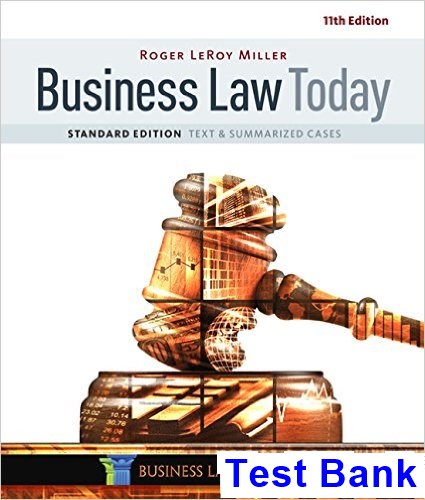Business Law Today Standard Text and Summarized Cases 11th Edition Miller Test Bank
$55.00 Original price was: $55.00.$29.99Current price is: $29.99.
Business Law Today Standard Text and Summarized Cases 11th Edition Miller Test Bank
This is completed downloadable of Business Law Today Standard Text and Summarized Cases 11th Edition Miller Test Bank

Product Details:
- ISBN-10 : 1305644522
- ISBN-13 : 978-1305644526
- Author: Roger LeRoy Miller
Interesting, clear, and applied, BUSINESS LAW TODAY: STANDARD EDITION, 11E is the ideal guide to the law and what it means in the business world — from contracts and secured transactions to warranties and government regulations. Easy to understand with an engaging writing style that is matched by vibrant visuals, BUSINESS LAW TODAY: STANDARD EDITION covers contemporary topics that impact not only the business world, but also your life. You examine the financial crisis and its impact on business law, identity theft, immigration law, and diversity issues. Fascinating features and intriguing cases highlight the practicality of the concepts you are learning. In addition, numerous learning support resources provide tools that address various learning styles.
Table of Content:
- Unit 1: The Legal Environment of Business
- Ch 1: The Legal Environment
- Learning Objectives
- 1-1: Business Activities and the Legal Environment
- 1-2: Sources of American Law
- 1-3: Common Law Tradition
- 1-4: Classifications of Law
- Appendix to Chapter 1
- Key Terms
- Chapter Summary: The Legal Environment
- Issue Spotters
- Learning Objectives Check
- Business Scenarios and Case Problems
- Critical Thinking and Writing Assignments
- Ch 2: Constitutional Law
- Learning Objectives
- 2-1: The Constitutional Powers of Government
- 2-2: Business and the Bill of Rights
- 2-3: Due Process and Equal Protection
- 2-4: Privacy Rights
- Key Terms
- Chapter Summary: Constitutional Law
- Issue Spotters
- Learning Objectives Check
- Business Scenarios and Case Problems
- Critical Thinking and Writing Assignments
- Ch 3: Courts and Alternative Dispute Resolution
- Learning Objectives
- 3-1: The Judiciary’s Role in American Government
- 3-2: Basic Judicial Requirements
- 3-3: The State and Federal Court Systems
- 3-4: Following a State Court Case
- 3-5: Courts Online
- 3-6: Alternative Dispute Resolution
- Key Terms
- Chapter Summary: Courts and Alternative Dispute Resolution
- Issue Spotters
- Learning Objectives Check
- Business Scenarios and Case Problems
- Critical Thinking and Writing Assignments
- Ch 4: Tort Law
- Learning Objectives
- 4-1: The Basis of Tort Law
- 4-2: Intentional Torts against Persons
- 4-3: Intentional Torts against Property
- 4-4: Unintentional Torts (Negligence)
- 4-5: Strict Liability
- Key Terms
- Chapter Summary: Tort Law
- Issue Spotters
- Learning Objectives Check
- Business Scenarios and Case Problems
- Critical Thinking and Writing Assignments
- Ch 5: Product Liability
- Learning Objectives
- 5-1: Product Liability
- 5-2: Strict Product Liability
- 5-3: Defenses to Product Liability
- Key Terms
- Chapter Summary: Product Liability
- Issue Spotters
- Learning Objectives Check
- Business Scenarios and Case Problems
- Critical Thinking and Writing Assignments
- Ch 6: Intellectual Property Rights
- Learning Objectives
- 6-1: Trademarks
- 6-2: Patents
- 6-3: Copyrights
- 6-4: Trade Secrets
- 6-5: International Protections
- Key Terms
- Chapter Summary: Intellectual Property Rights
- Issue Spotters
- Learning Objectives Check
- Business Scenarios and Case Problems
- Critical Thinking and Writing Assignments
- Ch 7: Internet Law, Social Media, and Privacy
- Learning Objectives
- 7-1: Internet Law
- 7-2: Copyrights in Digital Information
- 7-3: Social Media
- 7-4: Online Defamation
- 7-5: Privacy
- Key Terms
- Chapter Summary: Internet Law, Social Media, and Privacy
- Issue Spotters
- Learning Objectives Check
- Business Scenarios and Case Problems
- Critical Thinking and Writing Assignments
- Ch 8: Criminal Law and Cyber Crime
- Learning Objectives
- 8-1: Civil Law and Criminal Law
- 8-2: Criminal Liability
- 8-3: Types of Crimes
- 8-4: Defenses to Criminal Liability
- 8-5: Constitutional Safeguards and Criminal Procedures
- 8-6: Cyber Crime
- Key Terms
- Chapter Summary: Criminal Law and Cyber Crime
- Issue Spotters
- Learning Objectives Check
- Business Scenarios and Case Problems
- Critical Thinking and Writing Assignments
- Ch 9: Business Ethics
- Learning Objectives
- 9-1: Business Ethics
- 9-2: Business Ethics and Social Media
- 9-3: Approaches to Ethical Reasoning
- 9-4: Making Ethical Business Decisions
- 9-5: Global Business Ethics
- Appendix to Chapter 9
- Key Terms
- Chapter Summary: Business Ethics
- Issue Spotters
- Learning Objectives Check
- Business Scenarios and Case Problems
- Critical Thinking and Writing Assignments
- Unit 2: Contracts and E-Contracts
- Ch 10: Nature and Classification
- Learning Objectives
- 10-1: An Overview of Contract Law
- 10-2: Elements of a Contract
- 10-3: Types of Contracts
- 10-4: Quasi Contracts
- 10-5: Interpretation of Contracts
- Key Terms
- Chapter Summary: Nature and Classification
- Issue Spotters
- Learning Objectives Check
- Business Scenarios and Case Problems
- Critical Thinking and Writing Assignments
- Ch 11: Agreement
- Learning Objectives
- 11-1: Agreement
- 11-2: E-Contracts
- 11-3: The Uniform Electronic Transactions Act
- Key Terms
- Chapter Summary: Agreement
- Issue Spotters
- Learning Objectives Check
- Business Scenarios and Case Problems
- Critical Thinking and Writing Assignments
- Ch 12: Consideration, Capacity, and Legality
- Learning Objectives
- 12-1: Consideration
- 12-2: Promissory Estoppel
- 12-3: Contractual Capacity
- 12-4: Legality
- 12-5: The Effect of Illegality
- Key Terms
- Chapter Summary: Consideration, Capacity, and Legality
- Issue Spotters
- Learning Objectives Check
- Business Scenarios and Case Problems
- Critical Thinking and Writing Assignments
- Ch 13: Defenses to Contract Enforceability
- Learning Objectives
- 13-1: Voluntary Consent
- 13-2: The Writing Requirement
- 13-3: Sufficiency of the Writing or Electronic Record
- 13-4: The Parol Evidence Rule
- Key Terms
- Chapter Summary: Defenses to Contract Enforceability
- Issue Spotters
- Learning Objectives Check
- Business Scenarios and Case Problems
- Critical Thinking and Writing Assignments
- Ch 14: Third Party Rights and Discharge
- Learning Objectives
- 14-1: Assignments
- 14-2: Delegations
- 14-3: Third Party Beneficiaries
- 14-4: Contract Discharge
- Key Terms
- Chapter Summary: Third Party Rights and Discharge
- Issue Spotters
- Learning Objectives Check
- Business Scenarios and Case Problems
- Critical Thinking and Writing Assignments
- Ch 15: Breach and Remedies
- Learning Objectives
- 15-1: Damages
- 15-2: Equitable Remedies
- 15-3: Recovery Based on Quasi Contract
- 15-4: Contract Provisions Limiting Remedies
- Key Terms
- Chapter Summary: Breach and Remedies
- Issue Spotters
- Learning Objectives Check
- Business Scenarios and Case Problems
- Critical Thinking and Writing Assignments
- Ch 16: International Law in a Global Economy
- Learning Objectives
- 16-1: International Law
- 16-2: Doing Business Internationally
- 16-3: Regulation of Specific Business Activities
- 16-4: International Contracts
- 16-5: Payment Methods
- 16-6: U.S. Laws in a Global Context
- Key Terms
- Chapter Summary: International Law in a Global Economy
- Issue Spotters
- Learning Objectives Check
- Business Scenarios and Case Problems
- Critical Thinking and Writing Assignments
- Unit 3: Commercial Transactions
- Ch 17: The Formation of Sales and Lease Contracts
- Learning Objectives
- 17-1: The Scope of Articles 2 and 2A
- 17-2: The Formation of Sales and Lease Contracts
- 17-3: Title and Risk of Loss
- 17-4: Contracts for the International Sale of Goods
- Appendix to Chapter 17: An Example of a Contract for the International Sale of Coffee
- Key Terms
- Chapter Summary: The Formation of Sales and Lease Contracts
- Issue Spotters
- Learning Objectives Check
- Business Scenarios and Case Problems
- Critical Thinking and Writing Assignments
- Ch 18: Performance and Breach of Sales and Lease Contracts
- Learning Objectives
- 18-1: Performance Obligations
- 18-2: Anticipatory Repudiation
- 18-3: Remedies for Breach
- 18-4: Warranties
- Key Terms
- Chapter Summary: Performance and Breach of Sales and Lease Contracts
- Issue Spotters
- Learning Objectives Check
- Business Scenarios and Case Problems
- Critical Thinking and Writing Assignments
- Ch 19: Negotiable Instruments
- Learning Objectives
- 19-1: Types of Negotiable Instruments
- 19-2: Requirements for Negotiability
- 19-3: Transfer of Instruments
- 19-4: Holder in Due Course (HDC)
- 19-5: Signature and Warranty Liability
- 19-6: Defenses, Limitations, and Discharge
- Key Terms
- Chapter Summary: Negotiable Instruments
- Issue Spotters
- Learning Objectives Check
- Business Scenarios and Case Problems
- Critical Thinking and Writing Assignments
- Ch 20: Banking in the Digital Age
- Learning Objectives
- 20-1: Checks
- 20-2: The Bank-Customer Relationship
- 20-3: The Bank’s Duty to Honor Checks
- 20-4: The Bank’s Duty to Accept Deposits
- 20-5: Electronic Fund Transfers
- 20-6: Online Banking and E-Money
- Key Terms
- Chapter Summary: Banking in the Digital Age
- Issue Spotters
- Learning Objectives Check
- Business Scenarios and Case Problems
- Critical Thinking and Writing Assignments
- Ch 21: Security Interests and Creditors’ Rights
- Learning Objectives
- 21-1: Terminology of Secured Transactions
- 21-2: Creating and Perfecting a Security Interest
- 21-3: Scope of a Security Interest
- 21-4: Priorities, Rights, and Duties
- 21-5: Default
- 21-6: Other Laws Assisting Creditors
- Key Terms
- Chapter Summary: Security Interests and Creditors’ Rights
- Issue Spotters
- Learning Objectives Check
- Business Scenarios and Case Problems
- Critical Thinking and Writing Assignments
- Ch 22: Bankruptcy
- Learning Objectives
- 22-1: Mortgages
- 22-2: Laws Assisting Debtors
- 22-3: The Bankruptcy Code
- 22-4: Chapter 7-Liquidation
- 22-5: Chapter 11-Reorganization
- 22-6: Bankruptcy Relief under Chapter 12 and Chapter 13
- Key Terms
- Chapter Summary: Bankruptcy
- Issue Spotters
- Learning Objectives Check
- Business Scenarios and Case Problems
- Critical Thinking and Writing Assignments
- Unit 4: Agency and Employment Law
- Ch 23: Agency Relationships in Business
- Learning Objectives
- 23-1: Agency Relationships
- 23-2: Formation of an Agency
- 23-3: Duties of Agents and Principals
- 23-4: Agent’s Authority
- 23-5: Liability in Agency Relationships
- 23-6: Termination of an Agency
- Key Terms
- Chapter Summary: Agency Relationships in Business
- Issue Spotters
- Learning Objectives Check
- Business Scenarios and Case Problems
- Critical Thinking and Writing Assignments
- Ch 24: Employment, Immigration, and Labor Law
- Learning Objectives
- 24-1: Employment at Will
- 24-2: Wages, Hours, Layoffs, and Leave
- 24-3: Health, Safety, and Income Security
- 24-4: Employee Privacy Rights
- 24-5: Immigration Law
- 24-6: Labor Unions
- Key Terms
- Chapter Summary: Employment, Immigration, and Labor Law
- Issue Spotters
- Learning Objectives Check
- Business Scenarios and Case Problems
- Critical Thinking and Writing Assignments
- Ch 25: Employment Discrimination
- Learning Objectives
- 25-1: Title VII of the Civil Rights Act
- 25-2: Discrimination Based on Age
- 25-3: Discrimination Based on Disability
- 25-4: Defenses to Employment Discrimination
- 25-5: Affirmative Action
- Key Terms
- Chapter Summary: Employment Discrimination
- Issue Spotters
- Learning Objectives Check
- Business Scenarios and Case Problems
- Critical Thinking and Writing Assignments
- Unit 5: Business Organizations
- Ch 26: Sole Proprietorships and Franchises
- Learning Objectives
- 26-1: Sole Proprietorships
- 26-2: Franchises
- 26-3: The Franchise Contract
- 26-4: Franchise Termination
- Key Terms
- Chapter Summary: Sole Proprietorships and Franchises
- Issue Spotters
- Learning Objectives Check
- Business Scenarios and Case Problems
- Critical Thinking and Writing Assignments
- Ch 27: All Forms of Partnership
- Learning Objectives
- 27-1: Basic Partnership Concepts
- 27-2: Formation and Operation
- 27-3: Dissociation and Termination
- 27-4: Limited Liability Partnerships
- 27-5: Limited Partnerships
- Key Terms
- Chapter Summary: All Forms of Partnership
- Issue Spotters
- Learning Objectives Check
- Business Scenarios and Case Problems
- Critical Thinking and Writing Assignments
- Ch 28: Limited Liability Companies and Special Business Forms
- Learning Objectives
- 28-1: Limited Liability Companies
- 28-2: LLC Operation and Management
- 28-3: Dissociation and Dissolution of an LLC
- 28-4: Special Business Forms
- Key Terms
- Chapter Summary: Limited Liability Companies and Special Business Forms
- Issue Spotters
- Learning Objectives Check
- Business Scenarios and Case Problems
- Critical Thinking and Writing Assignments
- Ch 29: Corporations
- Learning Objectives
- 29-1: Nature and Classification
- 29-2: Formation and Financing
- 29-3: Corporate Powers
- 29-4: Directors and Officers
- 29-5: Shareholders
- 29-6: Major Business Forms Compared
- Key Terms
- Chapter Summary: Corporations
- Issue Spotters
- Learning Objectives Check
- Business Scenarios and Case Problems
- Critical Thinking and Writing Assignments
- Ch 30: Investor Protection, Insider Trading, and Corporate Governance
- Learning Objectives
- 30-1: Securities Act of 1933
- 30-2: Securities Exchange Act of 1934
- 30-3: State Securities Laws
- 30-4: Corporate Governance
- Key Terms
- Chapter Summary: Investor Protection, Insider Trading, and Corporate Governance
- Issue Spotters
- Learning Objectives Check
- Business Scenarios and Case Problems
- Critical Thinking and Writing Assignments
- Unit 6: Government Regulation
- Ch 31: Antitrust Law and Promoting Competition
- Learning Objectives
- 31-1: The Sherman Antitrust Act
- 31-2: Section 1 of the Sherman Act
- 31-3: Section 2 of the Sherman Act
- 31-4: The Clayton Act
- 31-5: Enforcement and Exemptions
- 31-6: U.S. Antitrust Laws in the Global Context
- Key Terms
- Chapter Summary: Antitrust Law and Promoting Competition
- Issue Spotters
- Learning Objectives Check
- Business Scenarios and Case Problems
- Critical Thinking and Writing Assignments
- Ch 32: Consumer and Environmental Law
- Learning Objectives
- 32-1: Advertising, Marketing, and Sales
- 32-2: Labeling and Packaging
- 32-3: Protection of Health and Safety
- 32-4: Credit Protection
- 32-5: Protecting the Environment
- 32-6: Air and Water Pollution
- 32-7: Toxic Chemicals and Hazardous Waste
- Key Terms
- Chapter Summary: Consumer and Environmental Law
- Issue Spotters
- Learning Objectives Check
- Business Scenarios and Case Problems
- Critical Thinking and Writing Assignments
- Ch 33: Liability of Accountants and Other Professionals
- Learning Objectives
- 33-1: Potential Liability to Clients
- 33-2: Potential Liability to Third Parties
- 33-3: The Sarbanes-Oxley Act
- 33-4: Potential Liability of Accountants under Securities Laws
- 33-5: Potential Criminal Liability
- 33-6: Confidentiality and Privilege
- Key Terms
- Chapter Summary: Liability of Accountants and Other Professionals
- Issue Spotters
- Learning Objectives Check
- Business Scenarios and Case Problems
- Critical Thinking and Writing Assignments
- Unit 7: Property and Its Protection
- Ch 34: Personal Property and Bailments
- Learning Objectives
- 34-1: Personal Property versus Real Property
- 34-2: Acquiring Ownership of Personal Property
- 34-3: Mislaid, Lost, and Abandoned Property
- 34-4: Bailments
- Key Terms
- Chapter Summary: Personal Property and Bailments
- Issue Spotters
- Learning Objectives Check
- Business Scenarios and Case Problems
- Critical Thinking and Writing Assignments
- Ch 35: Real Property and Landlord-Tenant Law
- Learning Objectives
- 35-1: The Nature of Real Property
- 35-2: Ownership Interests and Leases
- 35-3: Transfer of Ownership
- 35-4: Landlord-Tenant Relationships
- Key Terms
- Chapter Summary: Real Property and Landlord-Tenant Law
- Issue Spotters
- Learning Objectives Check
- Business Scenarios and Case Problems
- Critical Thinking and Writing Assignments
- Ch 36: Insurance, Wills, and Trusts
- Learning Objectives
- 36-1: Insurance
- 36-2: Wills
- 36-3: Trusts
- Key Terms
- Chapter Summary: Insurance, Wills, and Trusts
- Issue Spotters
- Learning Objectives Check
- Business Scenarios and Case Problems
- Critical Thinking and Writing Assignments
- Appendix A: How to Brief Cases and Analyze Case Problems
- How to Brief Cases
- Analyzing Case Problems
- Understand the Facts
- Legal Analysis and Reasoning
- Appendix B: The Constitution of the United States
- Appendix C: The Uniform Commercial Code (Excerpts)
- Article 1: General Provisions
- Article 2: Sales
- Article 2A: Leases
- Revised Article 3: Negotiable Instruments
- Addendum to Revised Article 3
- Revised Article 4: Bank Deposits and Collections
- Article 4A: Funds Transfers
- Revised Article 9: Secured Transactions
- Appendix D: Answers to Issue Spotters
- Appendix E: Answers to Even-Numbered Learning Objectives Check Questions
- Appendix F: Sample Answers for Business Case Problems with Sample Answer
- Appendix G: Case Excerpts for Case Analysis Questions
- Glossary
- Table of Cases
- Index
People Also Search:
business law today standard text and summarized cases
business law today standard text and summarized cases 11th edition
business law today standard text and summarized cases testbank download pdf
business law today standard text and summarized cases download scribd











